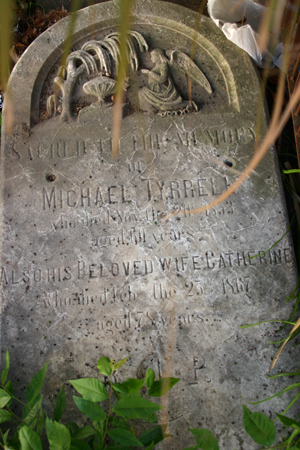
Finding English-language tombstones makes for a great scavenger hunt in Recoleta Cemetery.
Leave a Comment
Finding English-language tombstones makes for a great scavenger hunt in Recoleta Cemetery.
Leave a Comment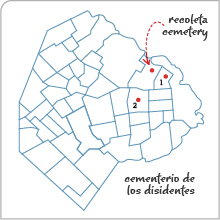
As the importance of trade made Buenos Aires grow, foreign merchants from around the world arrived. So did foreign ministers who recognized the new nation. But many of these new arrivals were not Catholic & therefore could not be buried inside local churches.
One year prior to the opening of Recoleta Cemetery, Governor Martín Rodríguez granted permission for non-Catholics—disidentes—to share a common burial ground. Their first cemetery was located on Calle Juncal, next to the Iglesia del Socorro in Retiro. With only 178 plots, it quickly filled to capacity & was closed in 1833. Nothing remains of this cemetery… a high-rise hotel occupies the spot today (#1 on the map above).
The Rosas government gave the non-Catholic community permission to acquire another piece of land, & the Cementerio Victoria opened in 1833 (#2 on the map above). Occupying almost an entire city block in Once, it was divided by nationality & religion into sections: British, German, American & Jewish. In 1892—59 years after opening—the lot had filled to capacity & the disidentes were on the move again.
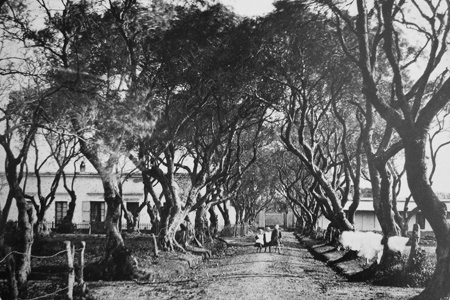
Remember that Chacarita Cemetery opened in 1871 due to a yellow fever outbreak. Since the land set aside was so large, a portion was allocated for non-Catholics with the idea that remains from the Cementerio Victoria would be transferred to the new location in Chacarita. In the end, some funerary monuments & tombstones were moved but most of the remains stayed in Once.
By 1919, the city government wanted to acquire the abandoned cemetery & convert it into a public space. Burials 1.5 m deep did not have to be transferred, provided that their families relinquished all rights to claim their ancestors. By 1924, 457 transfers were registered & the following year Buenos Aires obtained a new park: Plaza 1º de Mayo.
In 2006 during a refit of the plaza, work crews found remains of the former cemetery. Archaeologists arrived & began a thorough investigation of one sector. Besides uncovering a complete skeleton, they also uncovered many personal effects, marble tombstones & crosses. All items were cataloged & several put on display at the Cementerio Británico in Chacarita. Photos below are from 2006 during the dig:
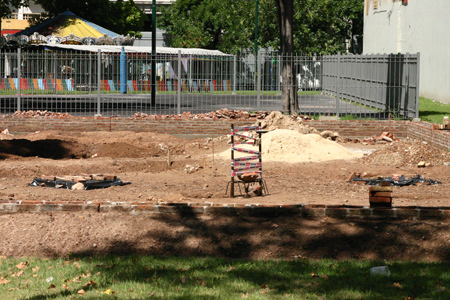
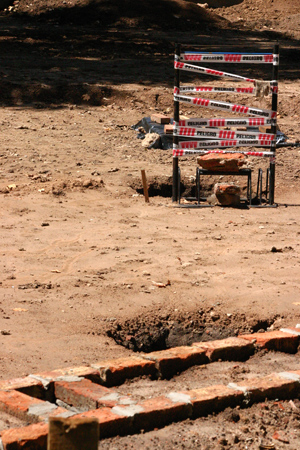
The city government under Mauricio Macri has currently abandoned many of the plazas reformed just a few years earlier. Plaza 1º de Mayo happens to be one of the worst cases in the city. Gravel for walkways has not been replaced & grass has disappeared once again… as if nothing had ever been done. Despite its poor condition, at least the excavated area has been gated off & protected. It is the only green area in the plaza these days:
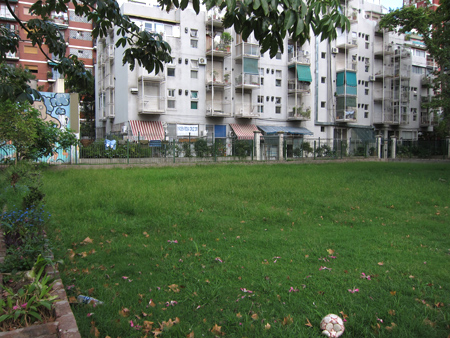
—————————————————
Other Buenos Aires cemeteries: Cementerio del Sur • Chacarita • San José de Flores • Cementerio de los Disidentes • Cementerio Británico • Cementerio Alemán
Archival photo taken by Esteban Gonnet, circa 1865. Courtesy of the New York Public Library, Wallach Collection. Full text of the findings by archaeologists can be found here (in Spanish).
Leave a Comment
In January 2012, the folks at Pilot Film & Television Productions contacted me about helping them with a new Buenos Aires episode of Globe Trekker. Of course I agreed. The idea was to show the production crew around the cemetery… essentially give them a tour of the highlights. Evidently I passed the test, because they wanted me to appear on camera with their presenter. Excellent!
The producers returned earlier this week & brought the camera crew with them. We ended up filming 3 hours inside the cemetery—much more than I originally thought—which will be edited down to a few minutes. I wonder what will be kept, what will be cut & most importantly, how I will look/sound on television 🙂
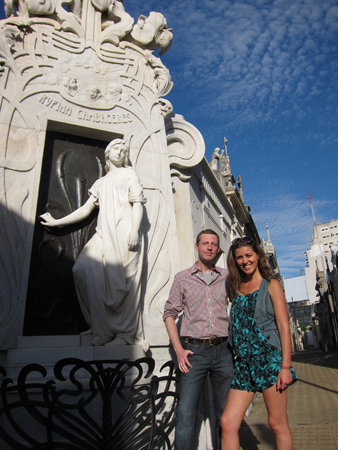
Judith, the presenter, filmed a short intro first then we did a bit about Aramburu & Eva Perón. Roca came next, followed by Firpo, Rufina & eventually Eva Perón. Unfortunately there was no time for Liliana. Even though that doesn’t sound like much, we had to do several takes for each tomb plus scenes of us walking through the cemetery. We left with the security guards hounding us out.
Since I had no idea which tombs they would request or how much time they wanted to spend on each, everything I said during the taping was completely ad-libbed. And although lifetimes & influence are difficult to sum up in a few words accurately, I think I managed to do ok.
The only way to know will be to see the final result. The producers could not give me a release date, but they will send me a DVD when it’s finished. Or maybe I’ll see it on cable tv first! I’m guessing October-ish & will definitely post some screen captures in this blog.
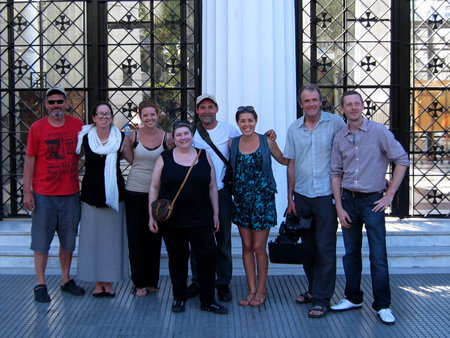
Many thanks to the Pilot crew & the crash course about working in front of the camera!
Update (Nov 2012): The show has been released… read about it in this post.
4 Comments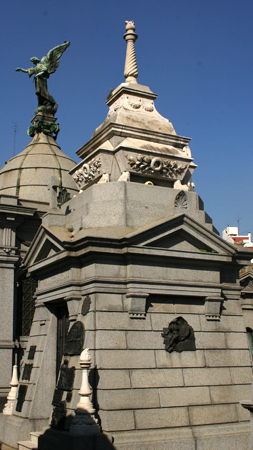
Born in Buenos Aires in 1838, Federico Lacroze quit his city job to make a small fortune in the town of Chivilcoy. Independently wealthy & known for his business savvy, the city government granted him a concession in 1870 to offer trolley service in Buenos Aires… horse-drawn at the time. Working with his brother, Julio—one of 10 siblings—their first line ran through downtown BA & connected Plaza de Mayo with Plaza Miserere (Once). In 1891, only three years before Lacroze passed away, they made the switch to electric trolleys.
Federico’s son, Teófilo, expanded the family business to include train lines & the B Line of the Buenos Aires subway system. A plaque shows visitors a bit of Federico’s history:
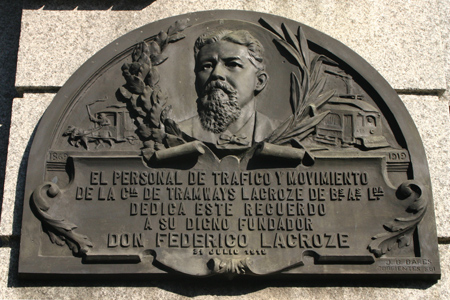
The mausoleum is striking… a Neoclassical temple with sculptures of eternal flames & representations of caskets on top:
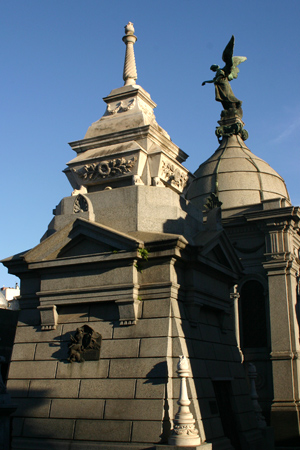
Julio Lacroze was the grandfather of Amalia Lacroze de Fortabat, the richest woman in Argentina with a fortune of almost U$S 2 billion. Although her family was already wealthy, marriage to concrete magnate Alfredo Fortabat in 1947 placed her at the top. A bit scandalous for the time, “Amalita” had to get divorced in Uruguay before marrying Fortabat… but it was true love. He passed away in 1976 & she inherited the company plus all the work involved in running it.
Painted by Andy Warhol & amassing a huge art collection, she donated many works to a new museum recently opened in Puerto Madero. In fact, she was known for her charity… donating millions to those in need & stimulating the arts in Argentina. In February 2012, Amalia died of natural causes in Buenos Aires & was laid to rest in the family tomb, just above Alfredo.
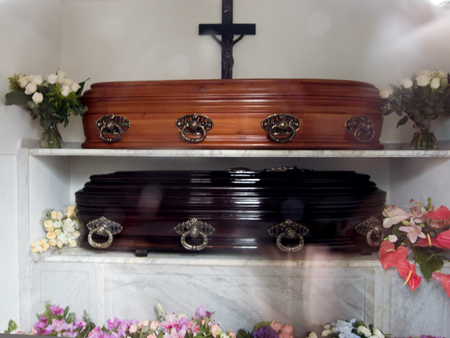
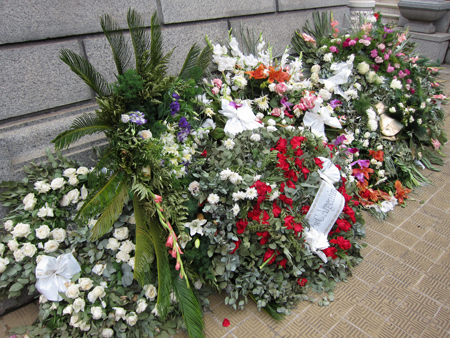
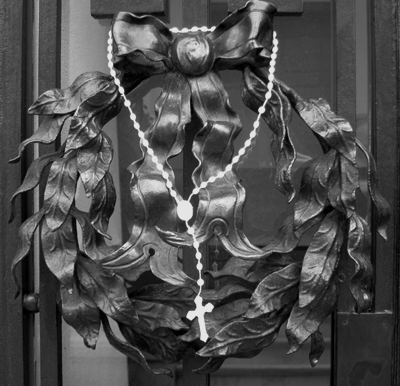
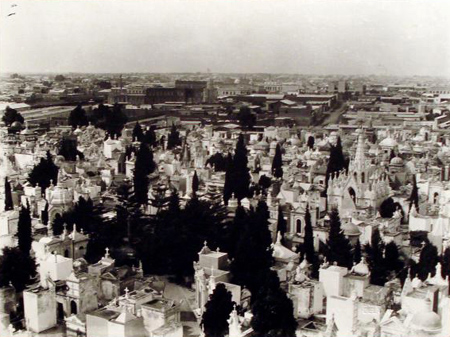
Photo #358 from the Colección Witcomb, date unknown. This capture shows the same perspective as another historic photo but much later… judging from the increasingly urban character of Buenos Aires visible towards Calle Azcuénaga in the background.
Update (10 Apr 2013): Something always bothered me about this photo. The single landmark I could find for orientation is facing the wrong way. How can that be? And the height from which the photo was taken means the photographer shot from the bell tower of the Iglesia del Pilar… there’s absolutely no other possibility, past or present.
Remembering that original images were from glass plate negatives, perhaps flipping the image horizontally in Photoshop would fix things. It did; everything fell into place. Below is how the image should look:
3 Comments